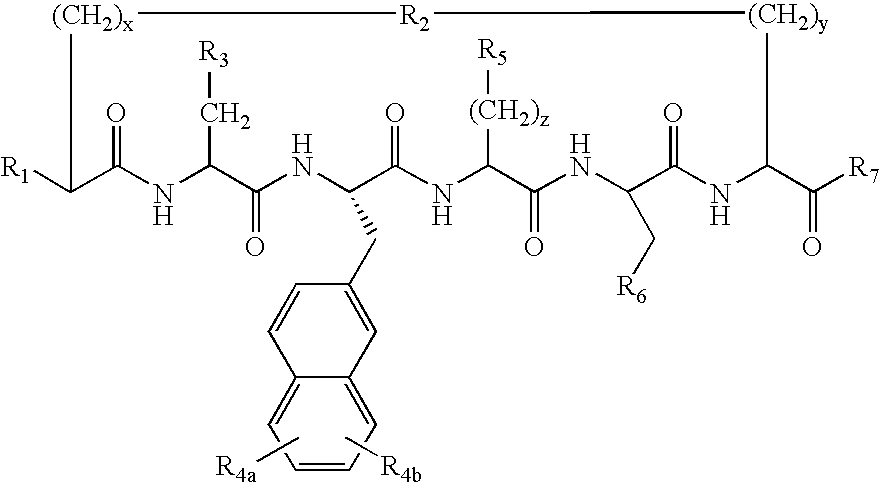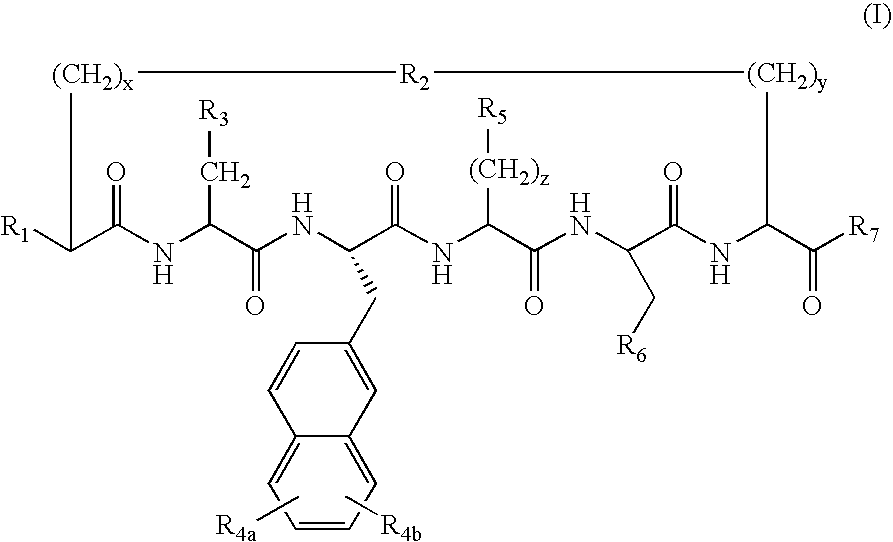Cyclic peptides for treatment of cachexia
a peptide and peptide technology, applied in the field of cyclic peptides, can solve the problems of obesity in mice and undesired loss of body weight, and achieve the effects of low dose, efficacy, and efficacy
- Summary
- Abstract
- Description
- Claims
- Application Information
AI Technical Summary
Benefits of technology
Problems solved by technology
Method used
Image
Examples
example 2
General Method for EC50 Determination in Functional Activity Assay
[0156] Functional evaluation of peptides at melanocortin receptors is performed by measuring the accumulation of intracellular cAMP in HEK-293 cells expressing hMC3-R, hMC4-R or hMC5-R, and in B-16 mouse melanoma cells expressing MC1-R. Cells suspended in Earle's Balanced Salt Solution containing 10 mM HEPES (pH 7.5), 5 mM MgCl2, 1 mM glutamine, 0.1% albumin and 0.6 mM 3-isobutyl-1-methyl-xanthine, a phosphodiesterase inhibitor, are plated in 96 well plates at a density of 0.5×105 cells per well. Cells are incubated with the test peptides in the presence or absence of α-MSH for 1 hour at 37° C. cAMP levels in the cell lysates are measured using the EIA kit (Amersham). Data analysis and EC50 values are determined using nonlinear regression analysis with Prism Graph-Pad software.
example 3
[0157] The agonist / antagonist status with respect to MC1-R, MC4-R and MC5-R of certain peptides of the invention is determined. Antagonistic activity is determined by measuring the inhibition of α-MSH-induced or NDP-α-MSH-induced cAMP levels following exposure to the peptides as in the preceding descriptions.
[0158] Assay for agonist. Evaluation of the molecules to elicit a functional response in HEK-293 cells expressing hMC4-R for agonistic activity is done by measuring the accumulation of intracellular cAMP following treatment. Confluent HEK-293 cells over-expressing MC4-R are detached by enzyme free cell suspension buffer. Cells are suspended in Earle's Balanced Salt Solution containing 10 mM HEPES (pH 7.5), 1 mM MgCl2, 1 mM glutamine, 0.5% albumin and 0.3 mM 3-isobutyl-1-methyl-xanthine, a phosphodiesterase inhibitor. The cells are plated in a 96 well plates at a density of 0.5×105 cells per well and pre-incubated for 30 minutes. The cells are then challenged w...
example 4
ICV Food Intake and Body Weight Change
[0162] Change in food intake and body weight is evaluated for selected peptides. Rats with indwelling intracerebroventricular cannulas (ICV rats) are obtained from Hilltop Lab Animals, Inc. (Scottdale, Pa.). Animals are individually housed in conventional plexiglass hanging cages and maintained on a controlled 12 hour on / off light cycle. Water and powdered (LabDiet, 5P00 Prolab RMH 3000) or pelleted (Harlan Teklad 2018 18% Protein Rodent Diet) food is provided ad libitum. For 1 week before treatment, 24-hour food intake and body weight change is recorded to assess a baseline for the group during vehicle treatment. The rats are dosed ICV with vehicle or selected cyclic peptides (0.3-3 nmol). The changes in body weight and food intake for the 24 hour period after dosing are determined. The changes in body weight and food intake for the 48 hour and 72 hour periods after dosing are also measured to determine reversal of changes in body weight and f...
PUM
| Property | Measurement | Unit |
|---|---|---|
| pH | aaaaa | aaaaa |
| pH | aaaaa | aaaaa |
| particle size | aaaaa | aaaaa |
Abstract
Description
Claims
Application Information
 Login to View More
Login to View More - R&D
- Intellectual Property
- Life Sciences
- Materials
- Tech Scout
- Unparalleled Data Quality
- Higher Quality Content
- 60% Fewer Hallucinations
Browse by: Latest US Patents, China's latest patents, Technical Efficacy Thesaurus, Application Domain, Technology Topic, Popular Technical Reports.
© 2025 PatSnap. All rights reserved.Legal|Privacy policy|Modern Slavery Act Transparency Statement|Sitemap|About US| Contact US: help@patsnap.com



